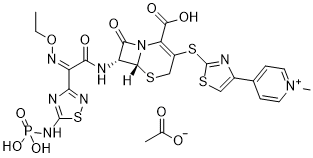| Cas No.: | 400827-46-5 |
| Chemical Name: | Ceftaroline fosamil |
| Synonyms: | Pyridinium, 4-[2-[[(6R,7R)-2-carboxy-7-[[(2Z)-(ethoxyimino)[5-(phosphonoamino)-1, 2,4-thiadiazol-3-yl]acetyl]amino]-8-oxo-5-thia-1-azabicyclo[4.2.0]oct-2-e n-3-yl]thio]-4-thiazolyl]-1-methyl-, acetate;(6R,7R)-7-[[(2Z)-2-ethoxyimino-2-[5-(phosphonoamino)-1,2,4-thiadiazol-3-yl]acetyl]amino]-3-[[4-(1-methylpyridin-1-ium-4-yl)-1,3-thiazol-2-yl]sulfanyl]-8-oxo-5-thia-1-azabicyclo[4.2.0]oct-2-ene-2-carbo;Ceftaroline fosamil;Pyridinium, 4-[2-[[(6R,7R)-2-carboxy-7-[[(2Z)-(ethoxyimino)[5-(phosphonoamino)-1, 2,4-thiadiazol-3-yl]acetyl]amino]-8-oxo-5-t;TAK 599;4-[2-[[(6R,7R)-2-Carboxy-7-[[(2Z)-(ethoxyimino)[5-(phosphonoamino)-1,2,4-thiadiazol-3-yl]acetyl]amino]-8-oxo-5-thia-1-azabicyclo[4.2.0]oct-2-en-3-yl]thio]-4-thiazolyl]-1-methylpyridinium acetate;PPI 0903;Teflaro;Zinforo;GTPL10899;Q409712;(6R,7R)-7-((Z)-2-(ethoxyimino)-2-(5-(phosphonoamino)-1,2,4-thiadiazol-3-yl)acetamido)-3-((4-(1-methylpyridin-1-ium-4-yl)thiazol-2-yl)thio)-8-oxo-5-thia-1-azabicyclo[4.2.0]oct-2-ene-2-carboxylate;(6R,7R)-7-[[(2E)-2-ethoxyimino-2-[5-(phosphonoamino)-1,2,4-thiadiazol-3-yl]acetyl]amino]-3-[[4-(1-me |
| SMILES: | S1C([H])([H])C(=C(C(=O)[O-])N2C([C@]([H])([C@@]12[H])N([H])C(/C(/C1=NSC(N([H])P(=O)(O[H])O[H])=N1)=N/OC([H])([H])C([H])([H])[H])=O)=O)SC1=NC(C2C([H])=C([H])[N+](C([H])([H])[H])=C([H])C=2[H])=C([H])S1 |
| Formula: | C22H21N8O8PS4 |
| M.Wt: | 684.6847 |
| Purity: | >99%, signal impurity<0.5% |
| Sotrage: | 2 years -20°C Powder, 2 weeks 4°C in DMSO, 6 months -80°C in DMSO |
| Description: | TAK-599 (ceftaroline fosamil) is a cephalosporin with activity against Gram-positive pathogens, including methicillin-resistant Staphylococcus aureus (MRSA). |
| In Vivo: | Ceftaroline fosamil is effective against all 10 MRSA isolates used in the dose-ranging studies and requires approximately 17 to 43% fT>MIC (the percentage of time that free drug concentrations remain above the MIC) to produce a 1-log10 kill[1]. The Ceftaroline Fosamil treatment results in mean reductions of 1.1 to 2.4 log10 CFU, with no relationship to the Ceftaroline Fosamil MIC. The use of high inocula does not affect the Ceftaroline Fosamil efficacy against the three strains tested, with mean decreases of 2.0 to 3.0 log10 CFU[2]. |
| Animal Administration: | Seventeen clinical S. aureus isolates (2 MSSA, 15 MRSA) are studied using the neutropenic lung infection model. Beginning 3 h after inoculation, groups of six mice receive treatment with Ceftaroline fosamil over a 24 h period. Ceftaroline fosamil doses are administered as 0.2 mL subcutaneous injections. Control animals are administered normal saline at the same volume, route, and frequency as the treatment regimens[1]. |
| References: | [1]. Bhalodi AA, et al. Efficacy of ceftaroline fosamil in a staphylococcal murine pneumonia model. Antimicrob Agents Chemother. 2012 Dec;56(12):6160-5. [2]. So W, et al. Comparison of in vivo and in vitro pharmacodynamics of a humanized regimen of 600 milligrams of Ceftaroline Fosamil every 12 hours against Staphylococcus aureus at initial inocula of 106 and 108 CFU per milliliter. Antimicrob Agents Chemother. 2014 Nov;58(11):6931-3. |

 DC Chemicals' products qualify for U.S. tariff exemptions. We guarantee no price increases due to customs duties and maintain stable supply, continuing to deliver reliable research solutions to our American clients.
DC Chemicals' products qualify for U.S. tariff exemptions. We guarantee no price increases due to customs duties and maintain stable supply, continuing to deliver reliable research solutions to our American clients.





















